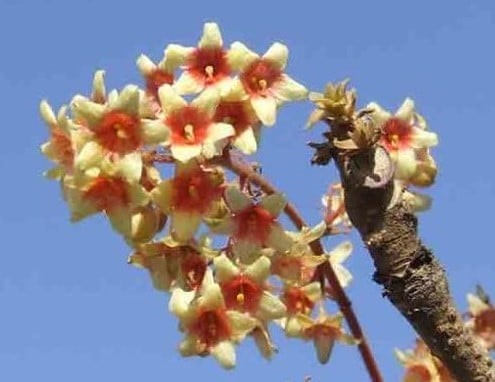
When I saw the blossoming of the flowers, I remembered a song of Kavi Guru, “Ore bhai, Fagun lange bane bane”. It is as if gold is falling from nature. There is only a golden glow all over the tree. It seems that some goldsmith made the flowers by melting gold. The whole tree has no leaves. From the branches only the golden udal hangs in bunches. Udal is found in our country but not very much in number. The tree is under threat.
Udal’s English names are Hairy sterculia and Elephant rope tree. Its scientific name is Sterculia villosa. This tree is a member of the Malvaceae family. Udal is a species of tropical Asia. Sardol is locally known as Udal or Udar in Northeast India. Udal trees are found in Bangladesh, China, Nepal, Bhutan, India, Myanmar, Thailand, Cambodia and many other countries of the world. Originally indigenous to South Asia as well as India. There is not much of this plant in Bangladesh.
Udal flower blooming time in spring or February in Bangladesh. Much like a cherry blossom, the tree has no leaves, but millions of blossoms. Flowers and flowers. Numerous small flowers bloom in a cluster. The shape of the flower is more like a bell (bell). Five-petalled yellow flowers with orange markings in the middle. Flower size 1.5 cm wide. Usually bisexual flowers and male flowers are found on the same plant. Panicles are about 15-30 cm long and grouped. The flowers are easily detached. The fluffy flowers glisten in the sunlight. In spring the plant looks beautiful with blooming flowers.
Udal is a medium sized deciduous tree. The height of the tree is 20 meters or more. The branches spreading towards the head are only full of flowers. The leaves of this tree fall in winter. Their bark is white. The leaves of Udal are long. Large leaves, leaf blades are grooved. The leaves are clustered on the stem. The leaves are glossy above and densely hairy below. A leaf blade of this plant is about 25 to 40 cm long. The lamina or leaf blade is composed of 5 to 7 lobes and is about 20 to 40 cm long. Several hairy fruits are clustered together on the branches of the tree. The fruit is 4 to 8 cm long. The fruit turns a beautiful red color when ripe. Each dried fruit contains several large black seeds.
This plant is grown from seed. Between January and April, the leaves are almost not visible on this tree. Numerous clusters of fragrant flowers bloom on long, drooping stalks of leafless branches. The seeds are smooth and black.
The wood of Udal tree is usually soft, light and brown in color. A type of fiber is obtained from the bark of the tree. Coarse rope is made from this fiber. A clear gum of coriander is also obtained from the Udal tree. This gum is used in many ways including confectionery. Light weight packing boxes are made from the wood of this tree. Apart from this, tea boxes are also made. The bark of Udal tree is characterized for making paper. This wood is used for fuel in rural areas of Northeast India and Bangladesh.
Just as almost every plant in nature has its medicinal properties, udaal plant also has many medicinal properties. Drinking its bark syrup keeps the body cool. The flower buds are squeezed and consumed in syrup with water and sugar to relieve urinary problems and gout pain. The flowers and bark of Udal tree are beneficial in increasing physical strength. According to Schedule-4 of the Wildlife Conservation and Security Act, 2012, Udal has been identified as a critically endangered species listed in Bangladesh. This tree needs more conservation. Otherwise, maybe this tree will be lost like many other necessary trees, we will lose a beautiful flower like Udal.
